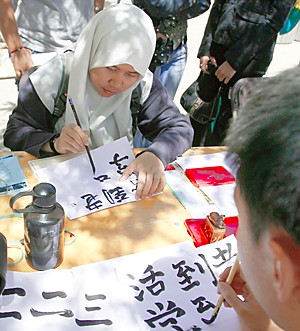The dean of the College of Humanities kicked off the Annual Southern Arizona Language Fair by greeting a crowd with a “”bonjour”” and “”buenos dias”” in two of the 13 languages represented at the UA fair on Saturday morning.
The UA has hosted the fair for more than 20 years and the event is put on by the College of Humanities and Partnership Across Languages, a coalition of educators that promotes cultural understanding through language learning, said John Urban, humanities program coordinator.
“”This gives students a chance to practice outside of the classroom the languages that they are learning,”” Urban said. He added that the fair provides an opportunity for students to see how they stack up against others who are learning the same language in different schools.
More than 1,200 students participated in the fair, which consisted of poetry, drama and oral proficiency competitions as well as onstage performances, booths, an art gallery and an international game room that represented a variety of languages.
Students ranging from grade school to college age came from all over Arizona to participate in the language fair.
The number of participants declined from about 1,400 last year because several high schools are on spring break, Urban said.
The event costs between $10,000 and $14,000 to put on, so the program booklet includes advertisements to help with the funding, Urban said.
Dora German, a teacher of English as a second language from Nogales High School, said she brought 22 students who recited poetry they picked or wrote themselves.
“”We’ve been coming for six years. It’s a reward for students because of the fun and competitions,”” she said.
Booths representing different countries were set up on the east side of the Modern Languages building to complement the competitions and performances going on inside some UA buildings.
Some people dressed in native clothing at their respective booths, decorated their booths with pictures of far away places, sold Italian food, sang in Spanish or performed Capoeira Mandinga dances to the beat of drums.
Hikmet Kocamaner, a non-degree-seeking grad student and teacher’s assistant for Turkish language classes, helped at the Turkish booth.
“”We are here to promote the Turkish language specifically, but the Turkish culture in general,”” he said.
Other students volunteered through the Asian Music Club on campus and in conjunction with the 17th Street Market, which sells world instruments. Manager Mark Neville said the market volunteered with hopes of promoting culture through music.
“”We feature international instruments from the 17th Market, and we’re here to promote local ethnic groups that emanate from the UA,”” he said, referring to the Asian Music Club.
Ping Zhou, an optical sciences graduate student and member of the Asian Music Club, said club members featured a variety of instruments and demonstrated how to play them. They also let people play a gong for 25 cents.
The booth displayed instruments such as the gu-zhang, a 21-string Chinese zither.
“”It’s very exiting (to perform) because there’s tons and tons of people looking at you, then you get the most attention,”” said Noel Noruega, a third-grader at Tucson International Academy.









